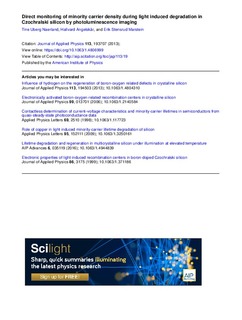| dc.contributor.author | Nærland, Tine Uberg | |
| dc.contributor.author | Angelskår, Hallvard | |
| dc.contributor.author | Marstein, Erik Stensrud | |
| dc.date.accessioned | 2017-10-30T14:45:06Z | |
| dc.date.available | 2017-10-30T14:45:06Z | |
| dc.date.created | 2013-07-24T09:33:06Z | |
| dc.date.issued | 2013 | |
| dc.identifier.citation | Journal of Applied Physics. 2013, 113 (19), . | nb_NO |
| dc.identifier.issn | 0021-8979 | |
| dc.identifier.uri | http://hdl.handle.net/11250/2462952 | |
| dc.description.abstract | In this paper, we present a new method for studying the light induced degradation process, in which the minority carrier density is monitored directly during light soaking by photoluminescence imaging. We show experimentally that above a certain minority carrier concentration limit, Δnlim, the boron oxygen (B-O) defect generation rate is fully independent of the injected carrier concentration. By simulation, we determine Δnlim for a range of p-type Czochralski silicon samples with different boron concentrations. The normalized defect concentrations, Nt*, are determined for the same samples by time-resolved Quasi Steady State Photoconductance measurements. After 10 min of light degradation, no correlation between Δnlim, and Nt* is observed. These results indicate that the role of the excess carriers during the rapid decay is to first change the charge state of the defects by shifting the electron quasi-Fermi level across the energy level of the defect centre in its passive state (Elat = EV + (635 ± 18) meV) and that, subsequently, another rate-determining step proceeds before the defect centre becomes recombination active. | nb_NO |
| dc.language.iso | eng | nb_NO |
| dc.publisher | AIP Publishing | nb_NO |
| dc.title | Direct monitoring of minority carrier density during light induced degradation in Czochralski silicon by photoluminescence imaging | nb_NO |
| dc.type | Journal article | nb_NO |
| dc.type | Peer reviewed | nb_NO |
| dc.description.version | publishedVersion | nb_NO |
| dc.source.pagenumber | 7 | nb_NO |
| dc.source.volume | 113 | nb_NO |
| dc.source.journal | Journal of Applied Physics | nb_NO |
| dc.source.issue | 19 | nb_NO |
| dc.identifier.doi | 10.1063/1.4806999 | |
| dc.identifier.cristin | 1040094 | |
| dc.relation.project | Norges forskningsråd: 181884 | nb_NO |
| dc.description.localcode | This article may be downloaded for personal use only. Any other use requires prior permission of the author and AIP Publishing. The following article appeared in Journal of Applied Physics and may be found at http://aip.scitation.org/doi/pdf/10.1063/1.4806999 | nb_NO |
| cristin.unitcode | 194,66,35,0 | |
| cristin.unitname | Institutt for materialteknologi | |
| cristin.ispublished | true | |
| cristin.fulltext | postprint | |
| cristin.qualitycode | 2 | |
